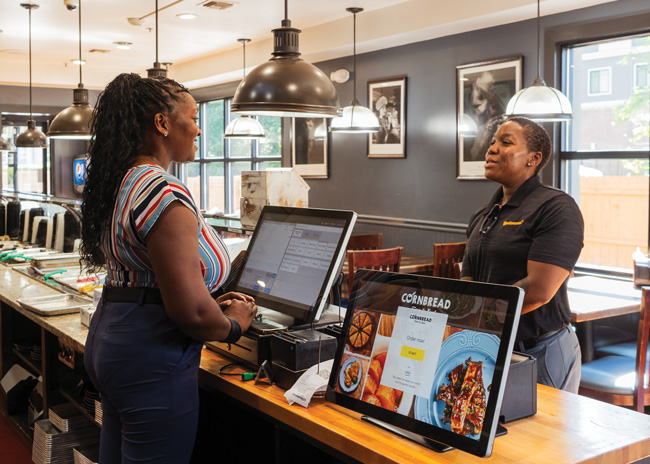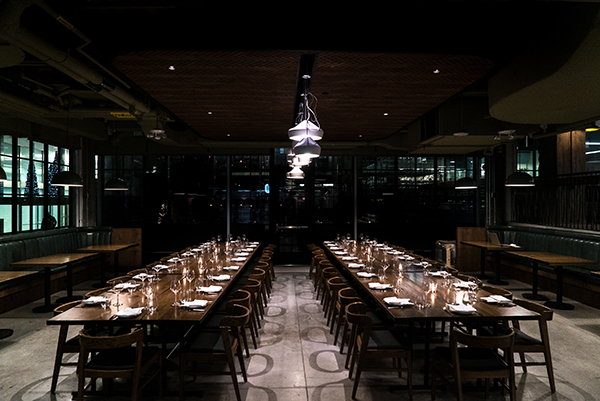Bars are often the heartbeat of a restaurant. They can be the reason some guests visit in the first place and can often be the place they linger after a meal.
And typically, restaurants want to encourage patrons to frequent the bar since beverage profit margins are higher than those on food. An attractive bar can entice people to drink pre- or post-dinner or can entice them to come for entirely different occasions.
Dan Simons recently opened Founding Farmers in Arlington, Va., where the bar is the first thing customers see as they enter.
“It was important that every guest who comes through the front door sees and feels and has their senses affected by the bar. If we’ve got it right, an appropriate amount of those sensory stimulation will flow to the dining room,” says the founder and co-owner of Farmers Restaurant Group in Washington, D.C.
 The backlit bar at Santi provides a lot of drama and makes it memorable. Image courtesy of Seth Caplan
The backlit bar at Santi provides a lot of drama and makes it memorable. Image courtesy of Seth Caplan
The Backdrop
Back bars can have a huge effect on a restaurant, and create a backdrop for diners as well as patrons in the bar.
But back bars don’t need to be all about alcohol, says Nancy Ruddy, founding principal of CetraRuddy, an architecture and interior design firm in New York City, who likes to add in branding references like artwork and knick-knacks. “That’s a trend, that you don’t have to be staring at this block of alcoholic beverages,” she says.
Paul Koch, AIA, senior architect, Dyer Brown & Associates, Boston, also likes to display artifacts and art pieces in the back bar to “really resonate the experience of the establishment and extend that story.”
Santi restaurant in New York City has a giant yellow back bar made of onyx and metal that’s backlit, which provides “a lot of drama,” says Rina Kukaj, partner, Michaelis Boyd, New York City. And because the bar in front of this is a horseshoe shape, all guests can admire it, she points out. Patrons, she says, “expect more from the spaces they go to and want more memorable experiences, so having that statement piece is something people enjoy.”
Bar Top Focus
Bar tops are becoming deeper as more restaurant customers eat at the bar. But they need to be practical, non-staining, non-absorbent, and also look like a million dollars.
A good rule of thumb is to make the bar top 6 to 8 inches deeper than a traditional bar, says Ruddy. Don’t make the bar top so deep that staff can’t reach over it, but make it wide enough to hold a dinner plate and a couple of glasses.
At Marcelino’s in Boston, Koch provided a larger bar because cocktail business is brisk, and the bar needed to hold the many glasses the bartenders use to create the cocktails.
Laura Middleton, founder of Laura Middleton Interiors, Cincinnati, Ohio, used marble for the bar top at Carmelo’s, Covington, Ky., because the owner wanted to use a natural material “but they’ll need to take care of it,” she says.
Another classic bar top material is stone, says Ruddy, pointing out that designers are cutting stone really thin, then mounting it to an aluminum honeycomb structure to add strength and reduce weight. Other bar top materials she likes are patinaed nickel/pewter, stone or concrete. She’s also been looking at some exciting new backlit stone bar top solutions and internally illuminated bar tops that use natural stone like alabaster and onyx.
Ruddy’s seeing more concrete bar tops, too, which can be pigmented or can have objects inset into them to continue a bar’s storytelling or to create something fun for customers and to warm up the concrete.
Leah Browning Frankl, interior designer and founder of Lumber & Light, Washington, D.C., recently switched the bar top at Founding Farmers Fishers & Bakers in the Georgetown neighborhood from a resin material to quartz, for social media purposes. “It’s much more suitable for people taking pictures of their drinks, she says. “You get a warm glow off it.”
 Interesting back bars can make them really distinctive. A special ceiling over a bar defines it and makes it stand out. Image of Queensyard in New York City designed by CetraRuddy courtesy of Will Stanley
Interesting back bars can make them really distinctive. A special ceiling over a bar defines it and makes it stand out. Image of Queensyard in New York City designed by CetraRuddy courtesy of Will Stanley
Bar Front Design
Little attention has been paid, to-date, to bar fronts, but they can be dramatic and designed to draw the eye, says Ruddy, especially if they’re lit. She likes to use mixed materials to create shades and shadows and geometric forms. The lighting also helps the bar front shine through when lots of people are standing in front of it.
Paul Koch used a glass tile to cover the bar front at Marcelino’s. It catches the light, he says, “and creates depth and interest.”
And at Carversteak, Las Vegas, Anwar Mekhayech, founding partner at DesignAgency, Toronto, Canada, created a bar front of backlit metal perforated panels surrounded by gold. “We wanted to make it beautiful because we knew you would see it more often than not,” he says.
 At the Langham Boston Hotel, Dyer Brown made the the bar a focal point and the chairs created pops of color. Image courtesy of Dyer Brown
At the Langham Boston Hotel, Dyer Brown made the the bar a focal point and the chairs created pops of color. Image courtesy of Dyer Brown
Standout Lighting
Lighting is arguably the most important factor in a bar to get right. Most designers like to layer it with back bar lighting, overhead pendants, under counter lights and sometimes some lamps sitting on the bar.
This is often the spot where designers add a knockout lighting fixture to really anchor the bar and make a statement.
“You want every person to look beautiful,” says Ruddy. She likes to light the back bar more brightly, then have a lower light on the bar itself, “to get that glow on people’s faces and to highlight glasses with the beautiful colored liquor in it.” She also likes to light up certain features within a bar.
At Pablo y Pablo in Seattle, Katherine Handziak, designer, Bluemustard, used 30 identical lamps from a local design studio, that hang at different heights to make the bar a focal point.
She leans toward candlelight for the back bar “because it has a lovely effect on the bottles.” On the bar itself, she likes task lighting or library task lights that can be moved around. However, she’s thinking of switching to rechargeable lamps instead of candles to reduce the labor required to light the candles every night.
At Marcelino’s, Koch included linear LEDs to illuminate the back bar and hanging globes above the bar itself. “The pendant globes are more ambient and all have different hues of warmth and coolness,” he says.
 A digital screen running around the top of the bar at Carversteak creates a unique moment. Image courtesy of Anthony Mair
A digital screen running around the top of the bar at Carversteak creates a unique moment. Image courtesy of Anthony Mair
Wow Moments
A bar is a great spot to have a “wow” moment. “You want to think: ‘What is my jewel?’” says Handziak. This could be as simple as a brass bar top when the other tables are wood, providing a beautiful contrast, she says. But don’t make everything stunning, she warns: “Pick where you want to be over the top.”
At Carversteak, the entire upper bar is wrapped in digital screens, creating a display that’s constantly changing and provides a high-tech energy and theatricality to the space.
“It’s one of the special moments, because it’s quite unique,” says Mekhayech. He was inspired by the over-the-top nature of Las Vegas and its many neon lights and digital screens as well as by betting and sports, which have scores listed on digital screens. The screen can be programmed to feature different patterns and colors, or can be used for names and advertising for buy-out events.
“The intention was for the screen to create different moods,” Mekhayech says. “We wanted to make it subtle and effective, but we didn’t want it to be overpowering like a nightclub or be too distracting or too crazy, because ultimately it’s a fine dining experience.”
This plays into the fact that bars are becoming more theatrical, Mekhayech says. “This is meant to be very dynamic, very fun, whacky.” Also in the bar is a Cookie Monster photo and some neon art. “It’s very pop art and colorful, and it feels very animated and theatrical.”
The new Farmers restaurant in Alexandria, Va., was inspired by a local apothecary founded in 1792 with ornate, beautiful cabinetry, which Browning Frankl wanted to replicate. She designed scalloped millwork archways with historic-looking decorative columns and finials that stand above the bar. “The Spirit of Distillation,” is an art installation within the central arches that features a dramatic display of blown glass vials, tubes and copper pipes. “It’s a dramatic, cornflower blue back bar, and it goes all the way up to the 15-foot ceiling. It’s a real wow moment,” she says. Big copper lanterns, also a modern take on more historic lighting, hang over the bar creating a beautiful glow.
Creating a special ceiling over a bar area is a great way to create a moment according to Ruddy. “At Queensyard in New York, the wood ceiling differentiates the bar space and creates a sense of intimacy in the middle of a large dining room. It also offers a tactile, warm contrast to the painted ceiling we have elsewhere in the restaurant,” she says.
At Bluebird London in New York, Ruddy created a glowing acrylic silhouette of a woman’s head with a ponytail behind the bar. “This sculpture is the focal point of the bar and doubles as a sculptural storage shelf for bottles.” Creating a focal point is another way to create a “wow” moment, she adds. “Often diners at the bar may have their back to the restaurant’s windows or view, so it’s important to create something interesting for these guests to look at.”
 Making a bar deeper not only allows more space for dining, but also for mixology, says Paul Koch. Image courtesy of Jared Kuzia
Making a bar deeper not only allows more space for dining, but also for mixology, says Paul Koch. Image courtesy of Jared Kuzia
Visible Everywhere
Bars contribute a lot of energy to the space they’re in, and ideally they’re visible from the main entrance, from the street outside, and from most of the dining room. This can help draw customers there before and after dinner.
Bars stand out simply through the high backbar, says Handziak, and she really encourages having the bartender build drinks facing out “so it’s theatrical.”
And with the greater interest in mixology these days, there’s greater showmanship by the bartender, says Ruddy, so she makes sure all the different elements for cocktails — from fruits to herbs and elements for smoking drinks — are visible. “People are interested in the drama and learning how to make the cocktails,” she says.
To emphasize the bar as a theater and as a center of the restaurant’s community, Ruddy sometimes raises it by two or three steps so guests at the bar can enjoy both seeing and being seen.
At Marcelino’s, the owners wanted their bar to be a stage, says Koch, so it is illuminated more than the surrounding areas. He also created a standout piece of art for the bar: a gilded wall installation that catches the light and creates drama on the back bar wall.
At Founding Farmers Alexandria, Dan Simons wanted to really showcase the guest and the product. “In bars in the past we’ve spotlighted the mixologist, and it was a performance. There’s been an evolution and it’s not so much about showcasing the bartender but creating an environment for lighting the guest,” says Simons. “It’s glowy, it draws you in.” The bottles here are also lit with a light, to emphasize the fact that the company distills its own drinks.
Different Shapes
Bars aren’t necessarily linear and if they curve, they can work with the architecture, such as at Carmelo’s, where Middleton curved the front of the bar to complement the geometry of the restaurant’s arches.
Ruddy likes to curve bars so guests can sit at 90 degrees to each other, or even curve them back on themselves so a small group can converse around the bend.
Kukaj likes curves because they create a much more social setting. “The curvature also allows the bar to immerse itself into the broader space and means it takes a confident stance,” she says.
However, although Koch designed a curved bar at Marcelino’s, he’s not a fan of shaped bars because there’s a lot of wasted space, especially behind refrigerators and the ice chest, he says. Visually, though, it works well at Marcelino’s, he says, as the bar flares out in the same shape as the ceiling and lights and soffits.
 At Founding Farmers in Alexandria, Va., the back bar features decorative elements that draw the eye. Image courtesy of Lumber & Light
At Founding Farmers in Alexandria, Va., the back bar features decorative elements that draw the eye. Image courtesy of Lumber & Light
Seating Choices
Bars are getting larger, says Ruddy, and often take up 20% to 25% of the space in a restaurant. Because of this, she’s adding more variety in the seating, from low banquettes to cocktail height seats, “so people can have a more informal experience before getting to dining table height.” And with more people eating in bars, this allows them plenty of options of what they’d like that experience to feel like and allows it to be different from the dining room.
Having a variety of seating types also means guests can have different experiences on different occasions. They might sit at a high-top table with a group of friends, but seek out an intimate booth with banquettes in the bar on date night. Ruddy also likes to light these areas differently, or use slightly different colors in them. And she aims to create areas within the bar so tries not to have continuous banquettes, but maybe some circular booths that can offer some privacy.
At Founding Farmers, it’s important that guests sitting on bar stools aren’t jostled by customers behind them. They’re comfortable, and swivel, says Simons “and the back goes around you enough so someone walking behind can’t touch you.”
While people want to see and be seen at a bar, they also want the opportunity for an intimate tete-a-tete. At Carmelo’s, Middleton included two signature red leather booths with a mirror over them, on a platform, where customers can be hidden but also have elevated views out.
Bar Practicalities
Include charging stations in bars. These can be under the counter on the guest side or can be wireless charging pads under the bar top, designated by a dot or an engraving, says Anwar Mekhayech, founding partner at DesignAgency, Toronto.
Server flow is important at a bar, says Katherine Handziak, designer, Blue Mustard, Seattle, who likes to have two separate spots for them — one for collecting drinks and one for dropping off the dirty glasses. “Some of our most successful bars have two entrances, so you don’t get stuck in that funnel. But a lot of bars only have one entrance, and they have to make sure there’s a good area for dropping off dirties, out of guests’ sight line and a place to pick them up.”
Include hooks under the counter for purses, bags and coats and make sure they’re sturdy.
Include footrails, especially if you’re offering food. These make it much more comfortable, says Nancy Ruddy, founding principal of Cetraruddy, New York City, as guests are in a more relaxed body position so more likely to linger.
Allow the front of the bar to be removed so you can get to the equipment if needed. Leah Browning Frankl, founder of Lumber & Light, Washington, D.C., included this in a recent remodel at Founding Farmers Fishers & Bakers in Washington, D.C. “The decorative elements look like applied molding but are removable panels and behind that is all the access to the bar equipment,” she says.



